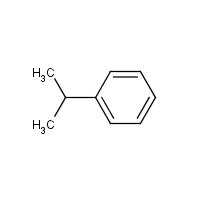Cumene
Agent Name
Cumene
CAS Number
98-82-8
Formula
C9-H12
Major Category
Solvents

Synonyms
(1-Methylethyl)benzene; 2-Fenilpropano [Italian]; 2-Fenyl-propaan [Dutch]; 2-Phenylpropane; Benzene, isopropyl; CUMENE; Cumeen [Dutch]; Cumol; Isopropilbenzene [Italian]; Isopropyl-benzol [German]; Isopropylbenzeen [Dutch]; Isopropylbenzene; Isopropylbenzol; Propane, 2-phenyl; [ChemIDplus] UN1918
Category
Aromatic Solvents
Description
Colorless liquid with a sharp, penetrating, aromatic odor; [NIOSH]
Sources/Uses
"In occupational settings, the main route of exposure to cumene is via inhalation during cumene manufacturing, processing, and use, primarily in the manufacture of phenol and acetone." [ACGIH]
Comments
Liver toxicity occurs in mice inhaling 500-1000 ppm daily for 17 days. TLV Basis is upper respiratory tract adenoma and neurological effects. [ACGIH] Inhalation of high concentrations may cause CNS effects; A skin, eye, and respiratory tract irritant; [ICSC] Fatty liver changes are noted in animals exposed to lethal doses; [HSDB]
Reference Link #1
Biomedical References
Exposure Assessment
Skin Designation (ACGIH)
Insufficient data
TLV (ACGIH)
5 ppm
PEL (OSHA)
50 ppm
MAK
10 ppm
IDLH (NIOSH)
900 ppm
Excerpts from Documentation for IDLHs
Daily exposures of rats to 500 ppm for 5 months resulted in no significant blood changes, although hyperemia and congestion were noted in the lungs, liver, and kidneys [Clayton and Clayton 1981].
Vapor Pressure
4.5 mm Hg
Odor Threshold Low
0.008 ppm
Odor Threshold High
0.13 ppm
Lethal Concentration
LCLo (rat) = 8,000 ppm/4H
Explanatory Notes
IDLH = 10% LEL (lower explosive limit); Detection odor threshold from AIHA (mean = 0.032 ppm); Flash point = 39 deg C;
NFPA
may ignite at ambient temp
Adverse Effects
Neurotoxin
Acute solvent syndrome
Hepatotoxin
Hepatoxic (a) from occupational exposure (secondary effect) or (b) in animal studies or in humans after ingestion
IARC Carcinogen
Possible (2b)
NTP Carcinogen
Anticipated human carcinogen
ACGIH Carcinogen
Confirmed Animal
Diseases, Processes, and Activities Linked to This Agent
Diseases
Occupational diseases associated with exposure to this agent:
Processes
Industrial Processes with risk of exposure: